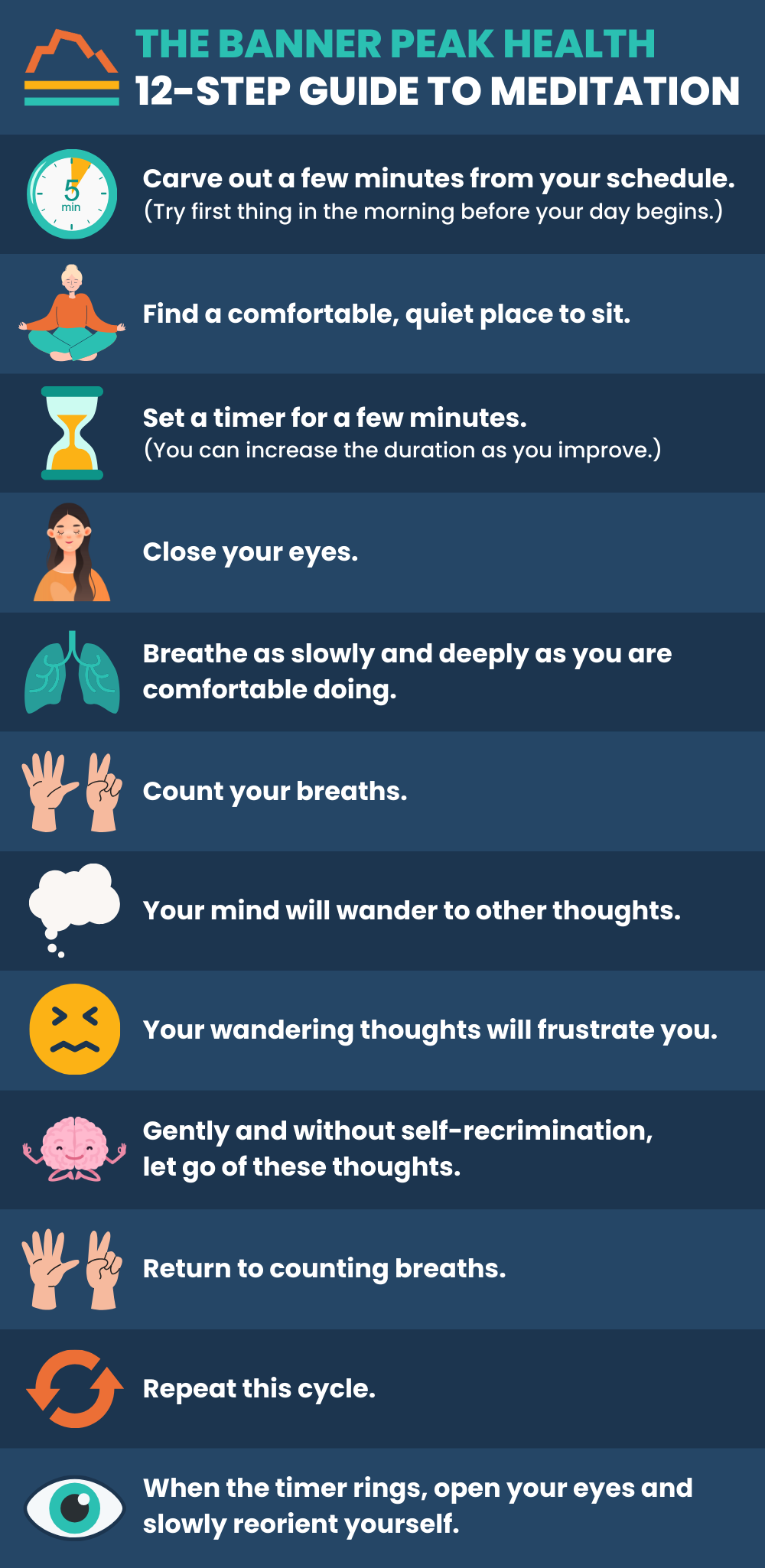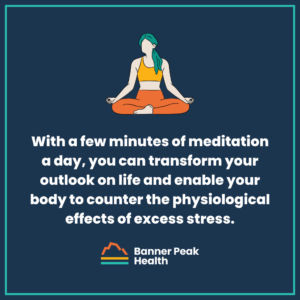I spend an inordinate amount of time writing about stress. It worsens almost every disease process in our bodies.
Emotional and physiological stress bombard us every day. Many sources of stress occur outside ourselves, and we have no control over them. We need to find coping methods to handle our stress burden.
We’ve discussed proven techniques such as exercise (particularly in natural surroundings), social support, avoiding excess alcohol, sufficient sleep, and therapy. There’s another tool we haven’t explored yet: meditation.
Meditation is a practice of relaxation that combines mental and physical techniques. There’s a vast array of meditation beliefs, practices, and traditions. Below, you’ll find the simple approach I teach my patients, which provides an easy starting point.
For many, this approach alone provides a noticeable benefit. Others pursue different or additional methods, including classes, videos, and apps. All meditation is good meditation!

The Breakdown
Here’s a more detailed look at the 12 steps.
1. Carve out a few minutes from your schedule for meditation.
Before taking your first meditative breath, you’ll need to consciously decide to prioritize meditation and carve out time for it.
We often place our physical and emotional needs at the bottom of our to-do list. It may seem selfish to focus on ourselves when there are more pressing tasks. Not infrequently, I work to convince patients to attend to their own care, not only for themselves but also to have more energy to give to others.
The decision to carve out time represents a crucial first step in this process. Meditating can reframe how we view our mental and physical health in the context of investing in ourselves in order to give to others.
2. Find a comfortable, quiet place to sit.
There’s no special position necessary. Do what feels most comfortable. Remember, you’ll be in this position for several minutes.
3. Set a timer for a few minutes. (You can advance duration as you improve.)
As you become more comfortable, you’ll be pleasantly surprised by how fast the time goes!
4. Close your eyes.
It’s that simple. You do it all the time.
5. Breathe in as deeply and out as slowly as you are comfortable doing.
A slow exhalation stimulates the parasympathetic nervous system (rest and digest).
Stress stimulates the sympathetic nervous system (fight or flight), but slow, deep exhalation suppresses it, allowing relaxation.
6. Count your breaths.
The number doesn’t matter. This is a technique to take your mind off other worries.
7–8. Your mind will wander to other thoughts, and this will frustrate you.
Your mind will race to other ideas. You’ll be frustrated and may even deem yourself a failure at meditation. Don’t.
Everyone is miserable at meditation because a perfect state of meditation doesn’t exist. Even monks who devote 20 hours per day to meditation humbly refer to their practice as “striving to improve.” That is the valuable lesson of meditation.
9. Gently and without self-recrimination, let go of these thoughts.
In meditation, as in life, we’re imperfect and will make mistakes. We achieve peace of mind by acknowledging this state of being and finding solace in our commitment to giving our best effort without reaching perfection. We must show ourselves kindness when dealing with our inevitable failures.
Thus, one of the main benefits of meditation is not only our thoughts during a few minutes a day but also how we reorient our perspective on expectations we have for ourselves.
10. Return to counting breaths.
You will lose count. It’s okay. Start again.
11–12. Repeat this cycle. When the timer rings, open your eyes and slowly reorient yourself.
Try not to anticipate the sound of the timer. Allow yourself to fully immerse in the meditation and enjoy the experience. When it’s over, allow yourself time to adjust.

The Benefits of Meditation
In addition to the psychological benefits of meditation, a growing body of evidence addresses the physical benefits.
As we’ve discussed in prior blog posts, there is a direct connection between our thoughts and emotions and the biology of our bodies. Meditation leverages this connection in a very positive direction.
Cortisol is our most prominent stress hormone. Too much can damage every organ system we possess. Fortunately, mediation can reduce cortisol levels, offsetting the rise in our stress-filled lives.
Researchers studying the brain note that during meditation, the brain’s electrical activity can change with enhanced alpha and beta wave activity, which enhances relaxation and learning function.
There are many examples in medical literature of the health-enhancing benefits of reducing stress with meditation, including reducing pain, enhancing sleep, improving memory, and reducing the intensity of illnesses such as irritable bowel syndrome, depression, and post-traumatic stress disorder.
Starting with a few minutes a day, you can transform your outlook on life and enable your body to counter the physiological effects of excess stress.
I hope I’ve piqued your interest in meditation. Please give it a try. Best of luck, and keep me posted!

Barry Rotman, MD
For over 30 years in medicine, Dr. Rotman has dedicated himself to excellence. With patients’ health as his top priority, he opened his own concierge medical practice in 2007 to practice medicine in a way that lets him truly serve their best interests.



